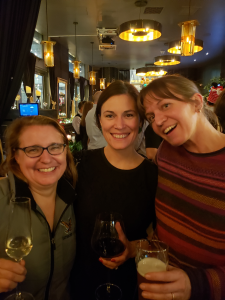(1) develops mutually respectful and productive relationships with colleagues
(2) partners consistently with colleagues on projects (i.e. integration, service learning)
(3) engages in collegial activities hosted by the school
The dynamic adult community at EPS creates a culture of synergy in work and play. I’ve heard through my professional network that being a specialist can be an isolating experience and I am grateful to not identify with that. In 2014-15 when I started at EPS I was basically running a one room schoolhouse for music. Each year since then I have felt more integrated in the school through the expansion of the music discipline by 100% (but really by 1000000%!) in the hiring of Dr. Ed Castro, through my discipline’s work in defining the F&PA group and art curriculum, as well as the general membership and friendships in the school adult community.
I love collaborating and do my best work this way. When Dr. Castro was hired I was so thankful to have someone with whom to brainstorm, and it turns out, the best planning that the music program does is unplanned. Lunch may last a long time one day and by the end of it Ed and I will have strategized our next concert finale (Rel-6), or planted seeds for a new approach to the theory curriculum. Ed’s skill in orchestrating have allowed us to think very creatively and outside the box of published works when planning repertoire, and his embrace of a variety of genres serves the students well and complements my own philosophy of music education.
As a discipline team, we have worked hard to synthesize our specialties and adopt a common language so students learn the same artistic process as they move through different art classes. The most integrated collaboration example from recent years the Peter Pan show that students re-imagined as a class project
Whitney Stange (drama), Melissa Hayes (PE) and I had small 7-8th grade classes scheduled at the same time as Amis Balcomb’s full section of art students, so we decided to combine them and put on a classroom musical. The students re-worked some of the script, changed the setting and modernized the characters, and added music. At other times we have found curricular connections in the performing arts, such as last winter ‘19 when Ed and I programmed music around Whitney’s US Production choice of Midsummer Night’s Dream. We wove music inspired by the story as well as set to Shakespeare text throughout the entire program.
The arts discipline is a collection of specialties that are grouped together because of process, not medium or content. I think our growth as a discipline lies in further defining that process, and integrating our work and philosophies to have a clear point of view as a discipline. It takes time to develop our identity as the school grows and personnel change. I have learned a lot in the last six years as the team has changed and I’m looking forward to taking on a more active leadership role as the Director starting next year. I would like to continue our work in building positive collegial dynamics through fun as well as serious endeavors. Celebrating successful events, finding more opportunities for collaboration, and weaving our yearly theme in to our class content will be important in building a strong team of colleagues.
At the broader school level, I appreciate being involved in the community outside of my academic discipline and performing arts responsibilities. Building relationships across my advisory team has helped me to better understand the grade level experience and the points of view of other disciplines. Leveraging the skill and knowledge of the dynamic adult community has helped in curriculum planning as well, inviting Dr. Olsen to help with Norwegian diction coaching, Mr. and Mrs. Mein with German, and Ms. Behrmann and Ms. Wallace with South African folk traditions. Working with Ed and Bess in incorporating music performances in to Black History month and MLK celebrations demonstrates music as a broad teaching tool (Rel-10). Attending social events hosted by the school has helped me to feel membership in the broader community and get to know my colleagues as people outside of the classroom and school mode  (Rel 12).
(Rel 12).
The fabric of a community and culture is weaved together during the in-between moments. The daily 7:50am backup at the overworked espresso machine in the TALI kitchen is where we can all squeeze in a quick check in and laugh or gripe, and maybe a handful of empty calories before rushing to class. The lunch table, where if you’re lucky you can linger and possibly plan the next collaboration, even though it wasn’t on your to do list. The hours after school and before an evening event where a group walks up the Corridor Trail for a quick breath of fresh and pre-show refreshment. And how could I possibly not mention the backdrop to so many adult gatherings, the Fish Dump. By the way, naming credit for that term of endearment goes to Verity Sayles, for the record. I am grateful to the EPS adult community for being such smart, thoughtful and funny colleagues, for lending hands and high fives, shoulders and tissues, laughs and libations.